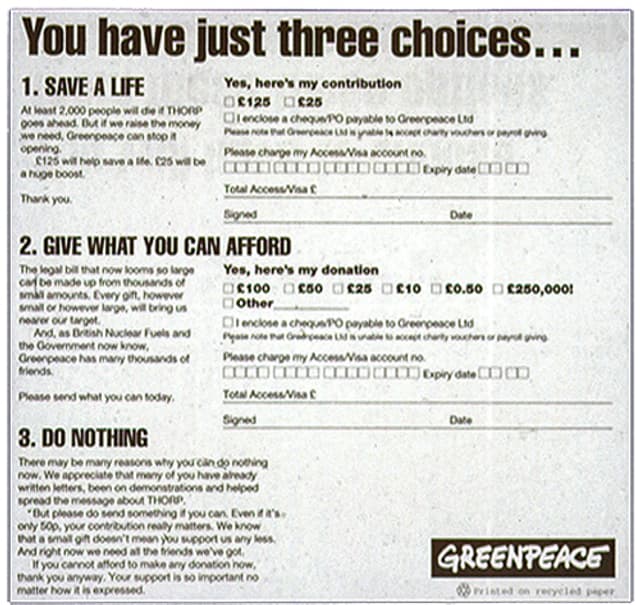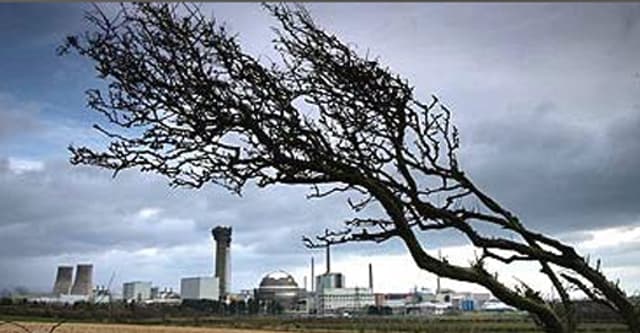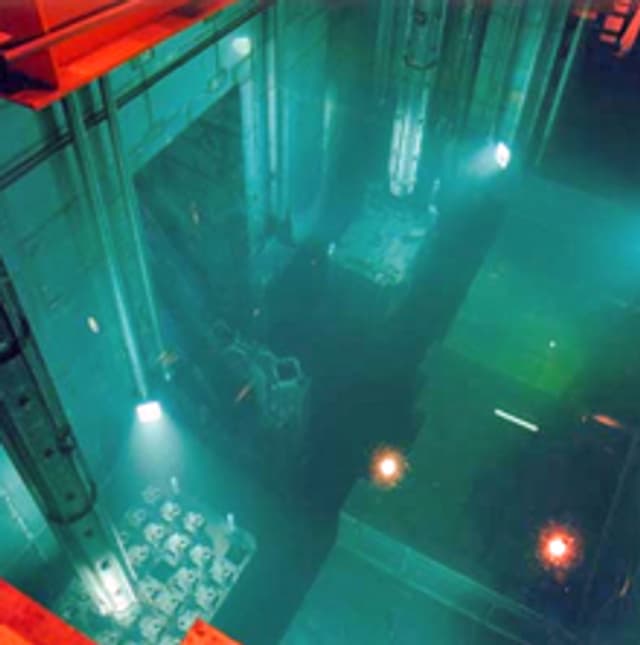Greenpeace’s optimistic tick-box suggestion: the ‘Stop Thorp’ campaign court case mailing
- Exhibited by
- Carolina Herrera
- Added
- September 08, 2013
- Medium of Communication
- Direct mail
- Target Audience
- Individuals, major gift, single gift
- Type of Charity
- Environmental/animals
- Country of Origin
- UK
- Date of first appearance
- Unknown
SOFII’s view
This exhibit works on many levels, which is why SOFII feels it’s a worthy member of our elite ‘best of the best’ showcase. At first glance the reply form opposite looks innocuous enough but really it’s a brilliant illustration of how, in times of need, donors will respond warmly to help a favoured cause when it is clearly in trouble. But first, you have to ask them properly...
The idea for a tick box asking for the full £250,000 came from Derek Humphries, then MD at Greenpeace’s agency, Burnett Associates. Burnett Associates’ clients at Greenpeace UK were Chris Williams, then head of fundraising, and Jan Chisholm, head of direct marketing. They were brave enough to go with the tick box idea, which many clients would not have had the courage to do. Brave clients get brave work.
To raise money to pay for anticipated court costs.
Background
Mid-way through the 1990s the firm British Nuclear Fuels, which back then ran several nuclear power and processing facilities for the UK government, took legal action against the campaigning organisation Greenpeace, who had been doing everything that they could to frustrate the opening of a new nuclear waste reprocessing facility at Thorp, Sellafield in the north of England. Though massively supported by public opinion, Greenpeace’s lawyers advised the campaigners that the case was unlikely to go anything other than BNFL’s way.
So Greenpeace turned to their supporters and appealed for funds to meet the costs of a court case they believed they were doomed to lose. The anticipated sum that they thought they’d have to fork out to cover legal costs was £250,000. Greenpeace donors responded generously, giving substantially more to the fighting fund than Greenpeace expected they’d be obliged by the Court to pay.
This mailing was also remarkable for the fact that, when creating the appeal for funds, a bright spark in the creative department of Greenpeace’s agency, Burnett Associates, suggested that alongside the usual direct mail prompt boxes for £10, £20, £50 and whatever, for this special appeal Greenpeace should include a prompt box for £250,000.
It seemed a zany idea, but a characteristically cheeky approach from Greenpeace. And it worked, because one donor did give £200,000. We’re still not quite sure why he didn’t give the full quarter of a £million. Mean, I guess.
Greenpeace did lose the case on a point of law, but the judge felt that they had the moral high ground so he awarded costs to the other side of just one penny. Having raised a lot of money that wasn’t needed for the purpose, GP did the only honourable thing and offered donors their money back. Only six took up the offer. (Burnett Associates pointed out to their client at the time, ‘we know where they live’.) The guy who gave two hundred big ones wasn’t among them. He and all the other generous supporters said to Greenpeace something like, ‘Keep it, we trust you to put it to good use’.
So, it can pay you if things don’t quite go according to plan.
Special characteristics
Possibly the first time that any major fundraiser has actually asked for such a huge sum via a tick box in an emergency appeal mailing – even if it was tongue-in-cheek.
Influence/Impact
More than anything, this exhibit is all about the real meaning of ‘brand’. The audacity of the tick box was entirely on brand for Greenpeace. So, as well as working, it didn’t alienate those who couldn’t give that much. And the money back offer did more to build brand trust than almost anything else Greenpeace might have done. So all in all, it was about an organisation wearing its values on its sleeve – and profiting hugely.
Results
As well as generating lots of lovely fan mail, Greenpeace received an additional £16,000 in donations from people who were inspired by the organisation’s honesty in offering the cash back.
Merits
A smart example of creative cheek, this really shows the truth in the old adage, 'if you don't ask, you don't get'.
Of the six people who asked for their money back, it transpired that four of them had never actually given any (Greenpeace didn’t have time to de-duplicate the givers against the non-givers when they sent the money back offer). Needless to say, their perhaps enterprising attempt to con money out of Greenpeace failed.
Follow-up on the project
SOFII received the following comment from Steve (04/07/2012):
Your backgrounder says that "BNFL... took legal action against the campaigning organisation Greenpeace..." Actually, Greenpeace took the Government to court, for a judicial review of the decision to licence the Thorp plant at Sellafield. BNFL chose to come to court as an interested party.
Greenpeace won on almost all the points of the case - setting precedents which still apply, and which have blocked other developments since, but failed to stop the Thorp plant on a couple of points.
There were no "damages" (nor could have been) - not even a penny. Because of the merits of the case the court ruled that each party should bear their own legal costs, so Greenpeace didn't have to pay the Government's legal fees (an arm and a leg) nor BNFL's costs. BNFL hoped to bankrupt Greenpeace with their enormous legal costs, with more wigs in court than in grand opera, but the judge wasn't having any of it. Greenpeace still had to pay its own legal fees - a six figure sum - but less than the amount raised, hence the refund offer.
I don't recall any single donor giving £200k - I think the whole appeal raised less than that (£196k comes to mind.) The style and layout of the mailing is very 1994 Greenpeace, also used in Greenpeace press ads of the time.
Unlike this mailing, the Thorp plant never worked properly; had frequent breakdowns and leaks; lost money throughout its life; and will cost another fortune to decommission. We'd all have been richer, and the world safer and cleaner, if Greenpeace had won the legal case in 1994.
Steve
Ken's correction, following Steve’s comments:
Having now consulted with the people responsible for this classic mailing at both Greenpeace and their agency (Jan Chisholm and Chris Williams, formerly of Greenpeace and Derek Humphries and Ken Burnett, formerly of Burnett Associates), it seems that Steve is right, in part at least.
It was Greenpeace who took the UK Government to court, seeking a judicial review of their decision not to hold a public enquiry into the license BNFL got to run the Thorp processing facility and to make discharges from it. Though there was a chance Greenpeace could win outright it was always more likely that, by the letter of the law, they would lose. British Nuclear Fuel’s tactic was to frighten Greenpeace off their action with the prospect of spiralling court costs. So Greenpeace appealed to its members and supporters.
The mailing raised between £360/400,000, much more than was expected and it also raised the bar for future campaigns. The day after the mailing dropped, Greenpeace’s CEO received a call from a well known donor (we’ll respect his request for anonymity) who said he’d received the mailing and understood we needed a quarter of a million and was happy to give it. Though, he never actually ticked the box!
Whether he coughed up or not is lost in time. Most likely before he needed to the judgement came in, so his generous gift was not required.
In the event Greenpeace did lose the court case but won many victories in the judgement. One of these was the understanding of the high court that paying the plaintiff’s costs might stop Greenpeace and other campaigning organisations from taking similar action in future. It was a big surprise and has acted as a precedent for other organisations, when taking companies to court.
Greenpeace did decide to offer donors their money back and indeed only six said they wanted it. Many more people sent even more money and the mailing more than paid for itself, raising an extra £16,000+. It is also true that two of the six wanting money back had never given in the first place.
We (Jan, Chris, Derek and Ken) hope this sets the record straight.
 View original image
View original image

























